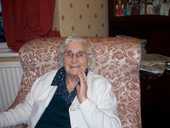“Wonderful Ellesmere!” A nonagenarian remembers…
Story: John Mellor
Anne Gilbert (nee Gray) was born in March 1914 (the first of five children), just a few months before the start of the "Great War" (later to become known as the First World War). Five of her uncles fought in that war; three of them returned from it, but two (Ben and Ebb) were killed, at the age of 21.
Anne has seen enormous changes in her lifetime, as I discovered whilst listening to her and her daughter Pat talk about their lives in Ellesmere.
She first lived in one of the cottages adjacent to the Sheffield Manor House, in what was then Manor Laithe, moving to City Road when she was 12 years old. Of that early part of her life Anne recalled:
"Several gangs operated in parts of Sheffield. On the Manor there was the 'Moony' gang who were heavily involved in gambling, which gave rise to shootings, murders and other crimes of violence. But they never bothered our family. If fact, if my mother heard them swearing as they walked past our house she'd tell them to 'watch their language' - and they did! However, a new police superintendent by the name of Shillito decided it was time to curtail the activities of these gangs and he started arresting them. Where serious capital crimes had been committed the culprits were executed. During this time I attended Manor School, leaving at the age of 14 to look after my newly born sister."
Just after the beginning of the Second World War in 1939, Anne married Wilfred and moved to Ellesmere. Their family home was in Lyons Street where their four children (Jim, John, Pat and Tony) were brought up. Recalling the war years Anne remembers:
"In December 1940 a German bomb landed close to the house but didn't explode. However, we had to move out of the house for 10 days while the bomb was made safe."
Pat added:
"Ellesmere was a wonderful place to grow up in, despite the fact that the back-to-back houses had no bathrooms and all the toilets were outside. There was a great sense of community and everyone knew everybody else. No-one ever bothered to lock their outside doors as there were no burglaries, in fact there was nothing worth stealing!"
Most of the men who lived in Ellesmere worked in the steel works or on the railways. Anne remembers that:
"Just before 6am every day you could hear the noise of the men running down the streets to be in time for the early shift! In August each year there were two shut-down weeks during which all the smoke and fog disappeared. The rest of the year the air was quite yellow with the fumes from the steel works. We had to wash our net curtains every week and the water smelt horrible!"
In 1951 Anne took over a draper's shop in Petre Street.
"This was a thriving shopping area which included five butcher's shops and five fish and chip shops as well as an offlicence, newsagent, greengrocer, cobbler and electrician. People didn't need to go into town to shop. The shop attracted a lot of customers from the local area."
Anne has had a long connection with the Guide movement, beginning as a Brownie in 1923, then becoming a guider in the groups at All Saints' and later St Peter's, and still continuing today in the Trefoil Guild which is celebrating the centenary of the Guiding movement this year.
Anne recalls:
"At the heart of the community was the school and church. All Saints' was a very good school; five former pupils later became Lord Mayors of Sheffield. Many community activities took place including a football team, tennis, a drama group, operatic society and swimming at Sutherland Road baths. However all this came to an end in the 1970s when the council decided to demolish nearly 300 houses in the area under a so-called 'slum-clearance' scheme. This resulted in local people being scattered around different parts of Sheffield and the sense of community was decimated very rapidly."
Pat added:
"In fact, many of the houses that were demolished were in good condition but the planners had decided that they wanted the whole of the area cleared. In 1974 a compulsory purchase order was put on our house, which was the last one standing in Lyons Street before the demolition was completed."
Although now living on the Longley estate is a regular visitor to Ellesmere where she is actively involved in a chairobics group and the life of the church and is an inspiration to all who know her.
The content on this page was added to the website by
Chris Blythe
on
2010-01-31 17:52:03.
The content of the page was last modified by
Chris Blythe
on
2010-01-31 18:08:27.
Follow us on Twitter @TheBMessenger
All content is copyright © Burngreave Messenger Ltd. or its voluntary contributors, unless otherwise stated, not to be reproduced without permission. If you have any comments, or are interested in contributing to the Messenger and getting involved, please contact us.
Burngreave Messenger Ltd. Abbeyfield Park House, Abbeyfield Road, Sheffield S4 7AT.
Telephone: 0114 242 0564. Email: mail@burngreavemessenger.org
Company Limited by Guarantee: 04642734
Registered Charity: 1130836
The Burngreave Messenger is a community newspaper with editorial independence, funded by the Big Lottery, Foyle Foundation, Trusthouse Charitable Foundation, the Garfield Weston Foundation, the Scurrah Wainwright Charity, local residents and our advertisers.




Logged in users of the website can add comments to this page.
Login to this site if you'd like to add a comment. Sign-up for an account if you are not currently a member.